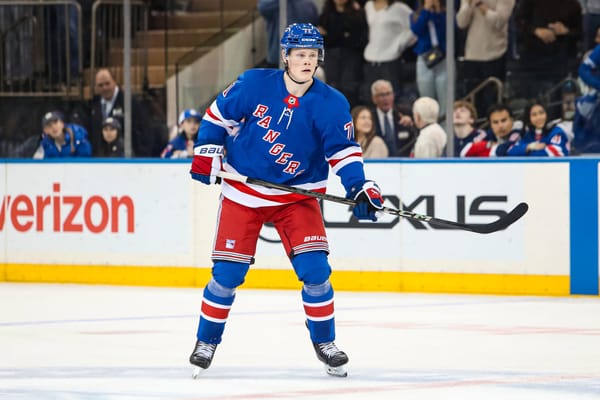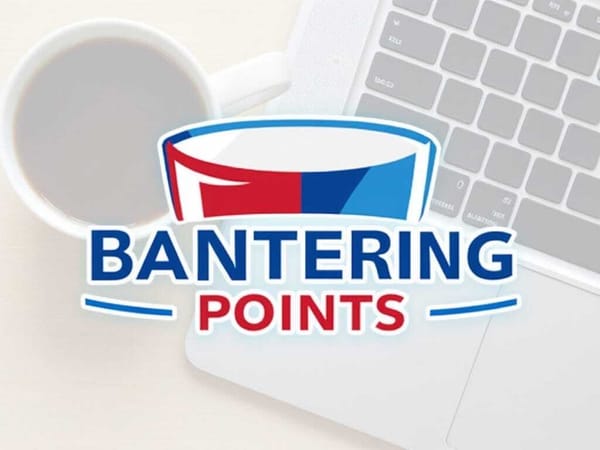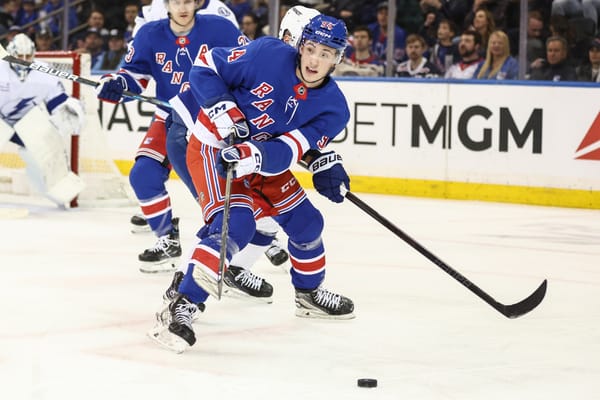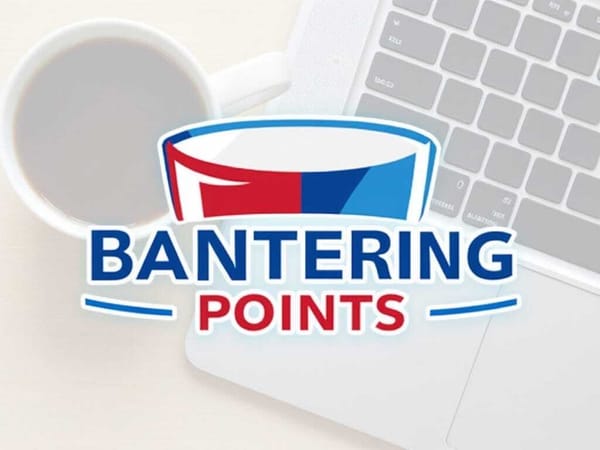Rangers Should Shift Focus to Development and Discovery of Players
The Rangers should take inventory of the talent they have internally. This includes players already on roster, and those in Hartford.
The NHL trade deadline is 53 days away, and we can assume that the New York Rangers’ roster will look different on February 25 at 3:01 p.m. than it does today.
The team has a variety of players who could and should be moved — many of whom we’ve discussed — and that movement will open opportunities for players in the organization.
Last night’s 7-2 drubbing at the hands of the Pittsburgh Penguins is a perfect illustration of a team that is currently propped up in the standings by seven loser points. Without these, the Rangers would have 34 points which would place them as the second-worst in the NHL.
The team will never admit they are tanking, nor will they intentionally ice a bad lineup. But the Rangers can take steps to integrate players from Hartford into their lineup in stages in the name of development and discovery. If you prefer the word evaluation, that is fine; I just liked the alteration of development and discovery. ¯\_(ツ)_/¯
Development would primarily apply to players such as Lias Andersson, Filip Chytil, Brett Howden and Alexandar Georgiev. There are others in the tweener category like Pavel Buchnevich and Jimmy Vesey, but they aren’t the primary focus here. The Rangers know varying amounts about each player in the group above, and post-deadline there are merits to seeing how each player handles a top-six role for a stretch of 10 games or so. Chytil has gone through this already on the wing, but he deserves an extended look down the middle. That move from wing to center would create opportunities for other players too.
Andersson was recently assigned to the Wolf Pack, and he should rejoin the team at a point where he is unable to surpass the 40-game mark in order to gain a year of experience which would push his UFA eligibility up a year. Right now playing on Hartford’s top line is the best thing for him, but ultimately it is in the Rangers’ best interest to give him another look with optimal conditions. The purpose of this would be to see if Andersson’s lack of performance was related to who he was playing with as opposed to him being not ready. There’s still a lot of time for Andersson, so I wouldn’t fret at this point.
Howden has primarily held down the third line, with some mixed results, and there are things that can be learned by having him play with a little better talent and against tougher competition. At this point of the season he’s due for a break — similar to the one Filip Chytil just received — as Howden’s hit the rookie wall. This doesn’t mean he won’t be able to get back in the swing of things at some point, but a rest and reset could do him some good.
Georgiev should have appeared in more than 10 games played at this point of the season, as there is no reason to trot out Henrik Lundqvist repeatedly in what essentially is a meaningless year in terms of contention. David Quinn admitted after the game that Lundqvist shouldn’t have started against the Penguins given the workload he faced in the last two games, and this experience could change his approach with goalies moving forward.
Going forward Georgiev should be treated more like a starter than as a backup so that the Rangers can learn more about him — or at least a more evenly split tandem. There is no reason why he can’t start three or four games in a row before Lundqvist rotates back in. Lundqvist isn’t going to like it, but that’s the way things should be to preserve him and learn more about the young netminder.
It’ll be hard for Quinn and Gorton to get a complete read on Georgiev given the state of the defense, but giving him the chance to get in a rhythm is important. He’s just 22 years old, and it would be ideal for the Rangers to know if he has the potential to be a future starter.
Igor Shestyorkin is seemingly the heir apparent to the throne, but there’s no way of knowing how he will adjust to North America. Georgiev may ultimately be an NHL backup, and there’s the potential he is a fringe player who is better suited for the AHL or Europe, but there’s no way of knowing at this point. That’s why it’s on the Rangers to find out now. Regardless, the Rangers want to have a number of options ready for when Lundqvist is ready to step aside, and being able to count on or count out Georgiev is a big piece of that puzzle. He’s had some mixed results with the Wolf Pack, but his NHL performance is what matters most, and the Rangers need to give him more of an opportunity.
I didn’t include him in the list, but you arguably could also include Neal Pionk in the development group. A lot of digital ink has been spilled over him as a player who is putting up points; underlying numbers be damned! But the Rangers owe it to themselves to get an understanding of what player he could be, and they would learn that by separating him from Marc Staal for an extended period since they’ve barely seen him in the NHL without him on his left. Who knows, maybe his underlying numbers improve a bit. Or they don’t. Either way, it’s helpful to know exactly what he is on his own.
You could also include Tony DeAngelo to an extent, but in his case it is a matter of him getting in a rhythm with playing time. He’s appeared in 25 games this season, and has been the odd man out on a number of occasions. Either way, the Rangers need to iron out a long term plan for him.
Discovery is a word that would apply to players such as Ville Meskanen, John Gilmour, Chris Bigras, Gabriel Fontaine, and Libor Hajek among others. This group has played primarily in the AHL — Gilmour has 28 games of NHL experience and Bigras has 48 with the Colorado Avalanche — so the Rangers should be interested in having each on their roster for varying reasons.
Ville Meskanen
In the case of Meskanen, he is fourth on the Wolf Pack in scoring with 22 points in 34 games and 11th among all AHL rookies.
Here’s a look at some of his numbers via Prospect-Stats:
The 23 year old winger spent last year in Finland playing for Ilves in Liiga and tallying 44 points (24 goals and 20 assists) in 48 games. This was an improvement upon the 20 points he tallied in 44 games the year prior. His production thus far has been good, although as pointed out by Zach Ellenthal, he’s got a good number of secondary assists.
*team-high 9 secondary assists
— Zach Ellenthal (@zellenthal) December 31, 2018
This isn’t the worst thing in the world though. If the Rangers create some holes in their lineup it would be wise to see what Meskanen can do at the NHL level.
John Gilmour
Gilmour is a name I bring up because I feel the Rangers should give him another shot. In a 28 game sample, the then 24-year-old rear guard had a Corsi for of 49.35 percentand a relative Corsi of 4.67 percent, along with a 48.6 expected goals for percentage that was a plus-4.98 relative to the team, according to Corsica. It’s a small sample, but his underlying metrics were positive during a tumultuous time for the Blueshirts. This season he’s third among the Pack, and first among defensemen, in scoring with 23 points in 34 games.
Chris Bigras
Chris Bigras came to the Rangers’ organization in a trade with Colorado involving Ryan Graves. In 52 total games with Hartford has five goals and 25 assists for 30 points.
This season his line is 17 points in 34 games which second among Pack defenders and seventh among all skaters. Bigras was selected 32nd overall in the 2013 draft, but ultimately didn’t stick on the Avalanche. His career high in points in a single AHL season is 19 — achieved in 37 games in 2015-16 — and he has a chance to surpass that this season. Bigras will turn 24 on Feburary 22, and he could be an option for the Rangers on left defense.
Gabriel Fontaine
Gabriel Fontaine was selected in the sixth round in the 2016 draft and plays center. He was a rookie last season and tallied nine goals and assists for 18 points in 68 games. Fontaine has appeared in 31 games this season and has five goals and eight assists for 13 points.
As you can see his time on ice is in the lowest section, but the majority of his other metrics are in the orange or blue with the exception of secondary assists which is a good thing. This gives some context for his production, as he is still very much a work in progress. He turns 22 on April 30 and thus far has shown some solid growth, so it would be nice to see him get some bottom-six minutes in a few weeks at the NHL level.
Libor Hajek
Last but not least is Libor Hajek, a player who carries the weight of being a major part of the Ryan McDonagh trade. Adam published a piece on December 17 going through Hajek’s season to date and the concerns he had. It was a continuation of some reservations he had when the Rangers made the trade in the first place and he looked at some historical examples. It was a measured analysis with the caveat,
Finally, we are still only talking about a 20-year-old with 28 AHL games to his name. That’s not fringe sample, but it’s hardly career defining, either.
Four hours after Adam’s story ran, a story on the team website ran with the headline “Hajek Progressing Well with Pack”.
¯\_(ツ)_/¯
All of that aside, not every NHL defenseman is going to produce offensively and that’s fine. You’d like to see it at the AHL level in some small doses — his 3 assists in 34 games in concerning — but ultimately defense is the name of the game. Hajek is someone the Rangers have a lot of confidence and faith in, so giving him a trial against NHL talent would be a good “stress test” to establish some benchmarks. There are tactical elements they can look at in terms of positioning, gap control, how he joins a rush and so on. In other words, the Rangers would be better off knowing what type of timeline they are looking at with him.
The Rangers’ last game before the trade deadline is Sunday, February 24 in Washington at 12:30 p.m. The deadline is Monday, February 25 at 3:00 p.m. with the Rangers’ first post-deadline game against the Tampa Bay Lightning on February 27. That is the first of 20 games that will be played post deadline. It’s a small sample, but it’s a sample the team can learn from by utilizing some of the young players currently in the system. If the Rangers were to start their sell off now, that would add games to the mix in which to evaluate the above youngsters.
It goes without saying that the Rangers will be augmenting their roster before next season, and severity of these changes are unknown at this point. But the more the Rangers know about the talent in house the better, because if they know that Fontaine can be a fourth-line center there is no need signing one for under $1 million at the start of free agency or acquire a prospect projected to become that at the deadline. The same applies to Bigras, Gilmour, and Hajek because if one or two of the three show qualities of being able to be NHL players it means that Jeff Gorton can focus elsewhere.
The Rangers are unlikely to solve all of their problems using players in house, but there is no harm in evaluating them sooner rather than later so they have an idea of what they have on hand, and what they need to go out and get to take the next steps in the rebuild process.
Stats via Elite Prospects and Prospect-Stats unless otherwise noted.





